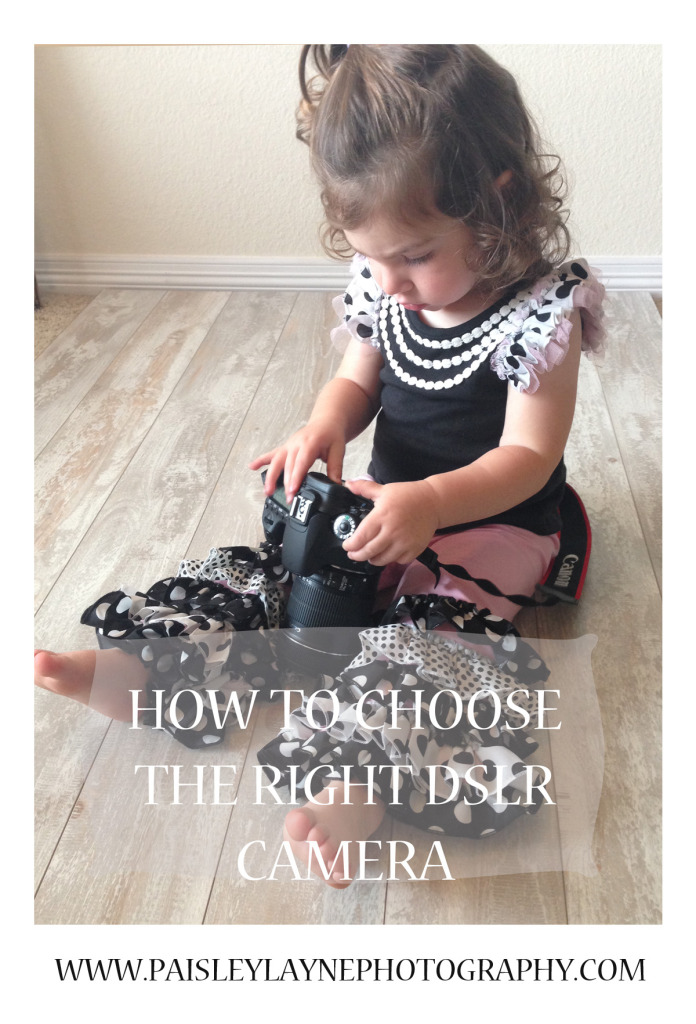As the holidays get closer I would guess that some of you may have a new camera on your wishlist. My first DSLR was a Christmas present from my husband several years ago {If only he knew what he was starting}. Chances are if you have thought about buying a DSLR camera, you are also a little overwhelmed by the choices out there. Here are a few tips and things to consider before buying your first camera.
Expensive DSLR does not equal professional quality photos. After I opened my camera on Christmas day and started shooting with it, I was disappointed to discover that there was no magic inside that black box that made my images as good as the professionals. It isn’t the camera that makes the amazing photos, it’s the photographer. Even though shooting in Auto on my DSLR still produced better images than my point and shoot camera, it wasn’t until I learned how to shoot in manual mode that I really noticed a difference {keep an eye out for a tutorial on switching to manual mode coming soon!}
Pay attention to the lens. When you purchase a DSLR you have the option of buying just the “body” (only the camera body, no lens) or you can buy it as a “kit” with the body and a lens. Most people don’t know that you have this option (big box stores usually only advertise it one way). Most cameras will come with a “kit lens”. It is typically a zoom lens that will allow you to start shooting right away in different situations. However, my suggestion is to figure out WHAT you plan to shoot and then choose a lens that works best for that type of photography. If you travel a lot and plan shoot landscapes or have a child that plays sports, you may want the option to zoom in from farther away. This is when the kit lens might work for you {or you could invest in an even larger zoom lens}. If you are shooting portraits and lifestyle images of your family then you could choose a really great fixed/prime lens to capture those moments. Knowing what you need from your lens will help you choose the best one to purchase.
Get an inexpensive prime lens instead of the “kit lens”. After I started to learn to shoot in manual I realized my “kit lens” didn’t allow me to capture the pictures I wanted. I wanted those lovely blurry backgrounds I saw in other photographer’s images and my lens wasn’t doing that for me. The typical kit lens probably has an aperture that only opens up to f/3.5. That is not a lot! Getting a lens with an aperture that can open up to f/1.8 allows you to get your subject in focus while the background is blurry. Check out my post on how to achieve blurry backgrounds if the term aperture is confusing to you! If you are looking to actually learn to use your camera one of the best ways to do that is to use a prime lens. I would recommend the 50mm f/1.8 or the 35mm f/1.8
. These are both relatively inexpensive lenses.
What is a prime lens you ask? A prime lens is a lens that has a fixed focal length AKA it doesn’t zoom. So for example that 50mm f/1.8 I was talking about will not zoom. It is set at 50mm f/1.8
and your feet have to move yourself forward or backwards. I love prime lenses and have both the lenses listed above along with an 85mm f/1.8. I know other photographers that swear by their zoom lenses, so I think it is all about preference. Local camera stores will usually let you play with their lenses in store, or rent them for a few days to test them out before you buy them. This is a great way to figure out what you like best.
Canon or Nikon? That is a personal decision. This is where that local camera store can come in handy as well. Take some time to try out both cameras. Hold them, play with them, ask questions. Figure out which brand and model is the most comfortable to you. If you are wanting to shoot on manual mode figure out how easy it is to adjust your shutter speed, aperture, and ISO. Don’t be afraid to ask the employees for help with this! Both Canon and Nikon have great starter DSLR cameras such as the Canon Rebel T5i and the Nikon D5300. Which ever camera you get be sure to check to see if it is compatible with the lens you want.
Keeping Your Camera Safe
Once you have invested in the right camera gear, you will want to make sure you have the right bag to keep it safe. I personally love a camera backpack because it allows me to easily carry and use my equipment without having to keep up with a shoulder bag or carrying case.
Visit https://www.globosurfer.com/best-camera-backpacks-for-hiking-and-travel/ for a great guide on choosing the best camera backpack for you whether you are hiking, traveling or just exploring your city with your new camera in tow.
I hope this helps you in your decision making process. I know that jumping into the world of DSLR cameras can be a little overwhelming so feel free to post your questions in the comments below and I will do my best to answer them for you.
Also, if you have recently purchased a DSLR camera and would like to learn more about shooting in manual mode, send me an email at hello@paisleylaynephotography.com


you said: